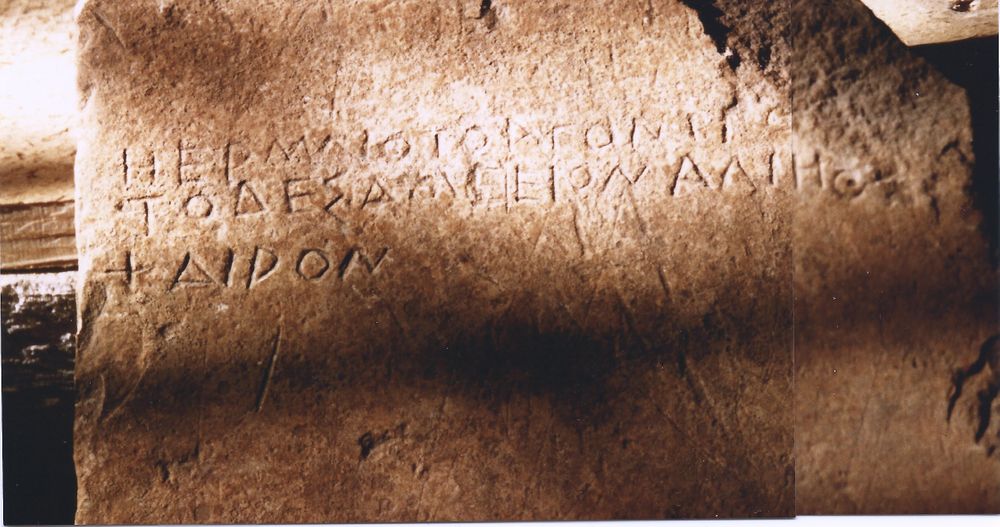EpiDoc XML:
IGCyr0815002
Trismegistos ID:
738385
Source description
Support: Small stele of local limestone, reddish from earth, broken off at all four angles (w: 0.265 × h: 0.38 × d: 0.006); below, there are some traces of a circular feature, probably a wreath or rosette; the back is not very regularly cut.
Layout: Inscribed on the face in three lines, the end of line 2 leaning toward bottom.
Letters: average 0.01, irregularly but rather carefully cut; alpha with low bar, epsilon with three equal bars, (h)eta with both values, slanting mu, nu and sigma, the latter very tall, rho with nearly no tail, + as chi.
Date: Probably second half of fifth century BC (lettering).
Findspot: Found before 1991 at Shtail, in the vicinity of Qasr Libya ➚; possibly from Kainopolis ➚.
Place of origin: Findspot.
Last recorded location: Cyrene Museum, 3504. Seen by C. Dobias-Lalou in 1997 and again in 2001 in Shahat: Cyrene Museum.
Text constituted from: Transcription from stone (CDL).
Bibliography
Dobias-Lalou 2015, pp. 77-80 and fig. 10, whence SEG, 65.2017; IGCyr 081500 ➚. Cf. Mohamed – Reynolds 1992, p. 115 (quick mention), whence SEG, 42.1661.
Text
Apparatus
1: Ἀγό̄νιιο[ς]: SEG mentioned as Ἄγώνιππος; Mohamed – Reynolds 1992 mentioned as Agonippos
French translation
La tombe que voici est celle d'Hermaios fils d'Agônis, pêcheur, (scil. édifiée par) Khairôn.
English translation
This is the tomb of Hermaios son of Agonis, a fischerman, (scil. built by) Chairon.
Italian translation
Questa è la tomba di Hermaios figlio di Agonis, pescatore, (scil. eretta da) Chairon.
Commentary
The spellings Ηερμαίō on one side, ἀλιῆος and σαμε͂ιον (once the erroneous duplication corrected) show a confused use of E and H, probably belonging to a time when the new value of eta was progressively coming into use. In fact, as psilosis happened early in Cyrenaican, the letter as spiritus asper was plausibly dropped earlier in the vocabulary than in a personal name; but its use in the new value of e cannot be assigned to a date earlier than the middle of the fifth century. Conversely, omicron is still used here for all qualities of the vowel o.
As noted by Mohamed and Reynolds, the provenance of the stone was a surprise, for Qasr Libya is mainly known for its Byzantine churches and no inscription was known up to now from that countryside. Dobias-Lalou supposes that the dead Hermaios, being a fisherman, lived probably in a place somewhat nearer to the see than Qasr Libya, perhaps in the kome of Kainopolis (see Laronde 1983). Anyway, both places belonged at the time to the territory of Barce.
Although several metrical segments are perceivable, we decided eventually not to include this item into the verse-inscriptions corpus. See for instance Ἑρμαίω τῶ Ἀγώνιος, which might be spelled as three dactyls if it was not followed by a consonant, and -ος τόδε σαμεῖον, which might be spelled as the second hemistich of a hexameter after a hephthemimer caesura. Another fact that provides a poetic touch to this inscription is the mention of Hermaios' occupation, a fact that usually does not occur in prose epitaphs.
CC BY-NC-SA 4.0 Deed Attribution-NonCommercial-ShareAlike 4.0 International License.
All citation, reuse or distribution of this work must contain a link back to DOI: https://doi.org/10.60760/unibo/igcyrgvcyr2 and the filename (IGCyr000000 or GVCyr000), as well as the year of consultation.

